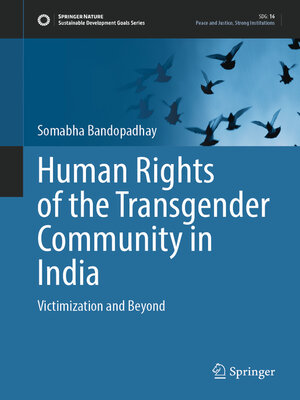Human Rights of the Transgender Community in India
ebook ∣ Victimization and Beyond · Sustainable Development Goals Series
By Somabha Bandopadhay

Sign up to save your library
With an OverDrive account, you can save your favorite libraries for at-a-glance information about availability. Find out more about OverDrive accounts.
Find this title in Libby, the library reading app by OverDrive.



Search for a digital library with this title
Title found at these libraries:
| Library Name | Distance |
|---|---|
| Loading... |
This book records real-life experiences of transgender violence and victimisation, analysing the legal lacunae in granting protection to the historically vulnerable community and their perspective of the law and safety. It is an outcome of extensive empirical legal research conducted in the state of West Bengal, India. With exploration of global scenario of violence, a systematic pattern of victimisation has been identified leading to a reasonable conclusion of internationalisation of transgender violence and victimisation that is largely ignored and is bereft of any legal protection. Premised on the fact that without safety and protection against grave crimes, no amount of civil rights protection is effective, the book provides an account of the ever-increasing gravity of transgender violence and victimisation. Recognising that there is a paucity of research on type of targeted violence against transgender persons, yet even with that scarcity of consistent and reliable reporting to official law enforcement sources, the data that is available from governments, public interest groups, and community surveys about SOGI motivated violence reveals that precarity, prevalence, violence and the harm caused are graver as against other types of crimes and crimes against LGB population,, the author deliberately chose to focus on unearthing violence and victimisation. The culturally sensitive approach to the problem is first of its kind in the legal landscape and expects to contribute to the developing jurisprudence.
The book navigates through the transgender jurisprudence to conclude that attempts made by the law-makers across the world is only tokenistic and that the real pulse of the community is far from being recognised in law. The in-depth interviews with law enforcement bodies and transgender activists and victims reveal gaps between laws and realities, whose impact assessment has been attempted in the book to suggest possible best practices to reduce vulnerability and auger empowerment. The book expects to open doors for more legal and interdisciplinary research, in India and abroad by scholars of law, sociology, victimology and others.







